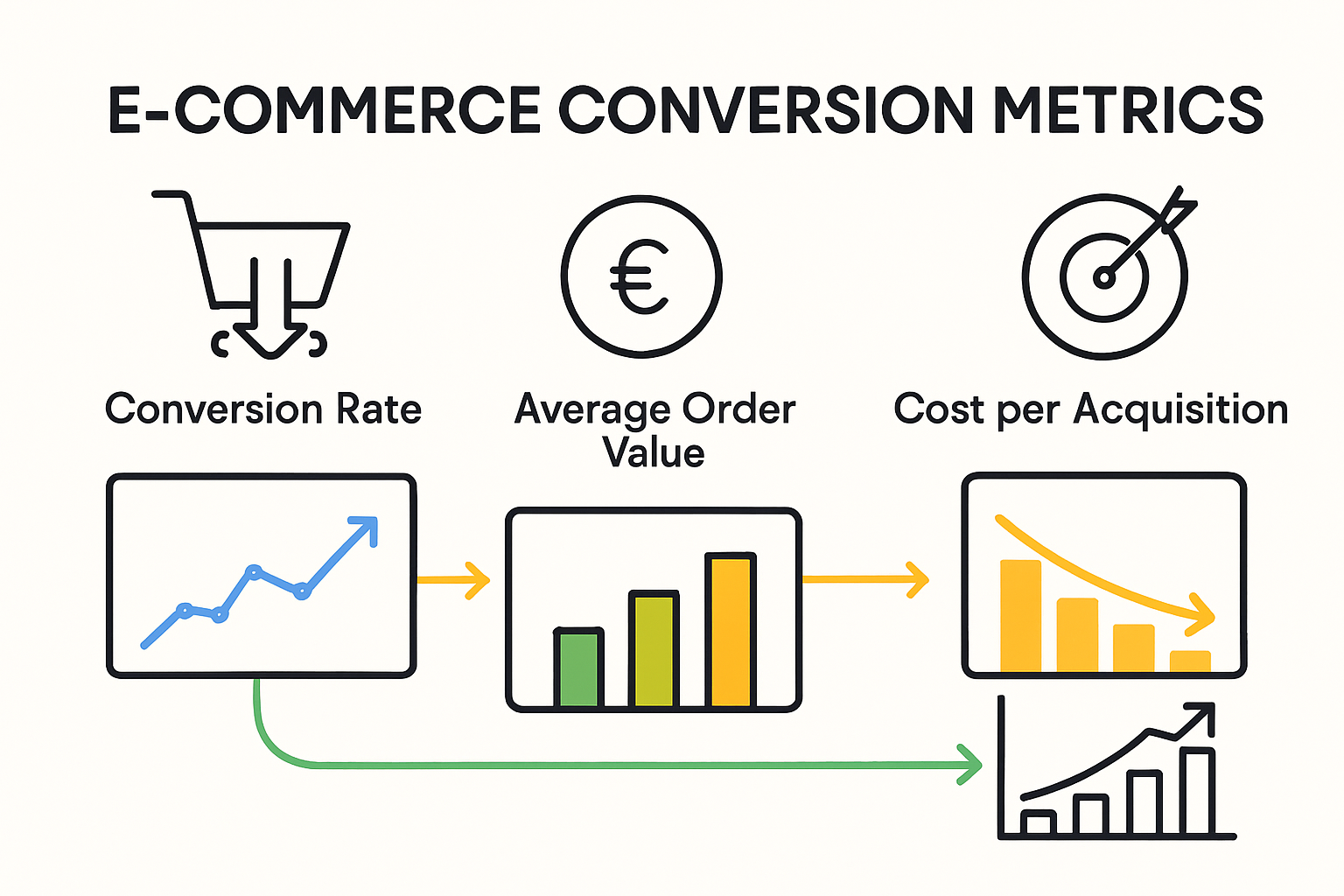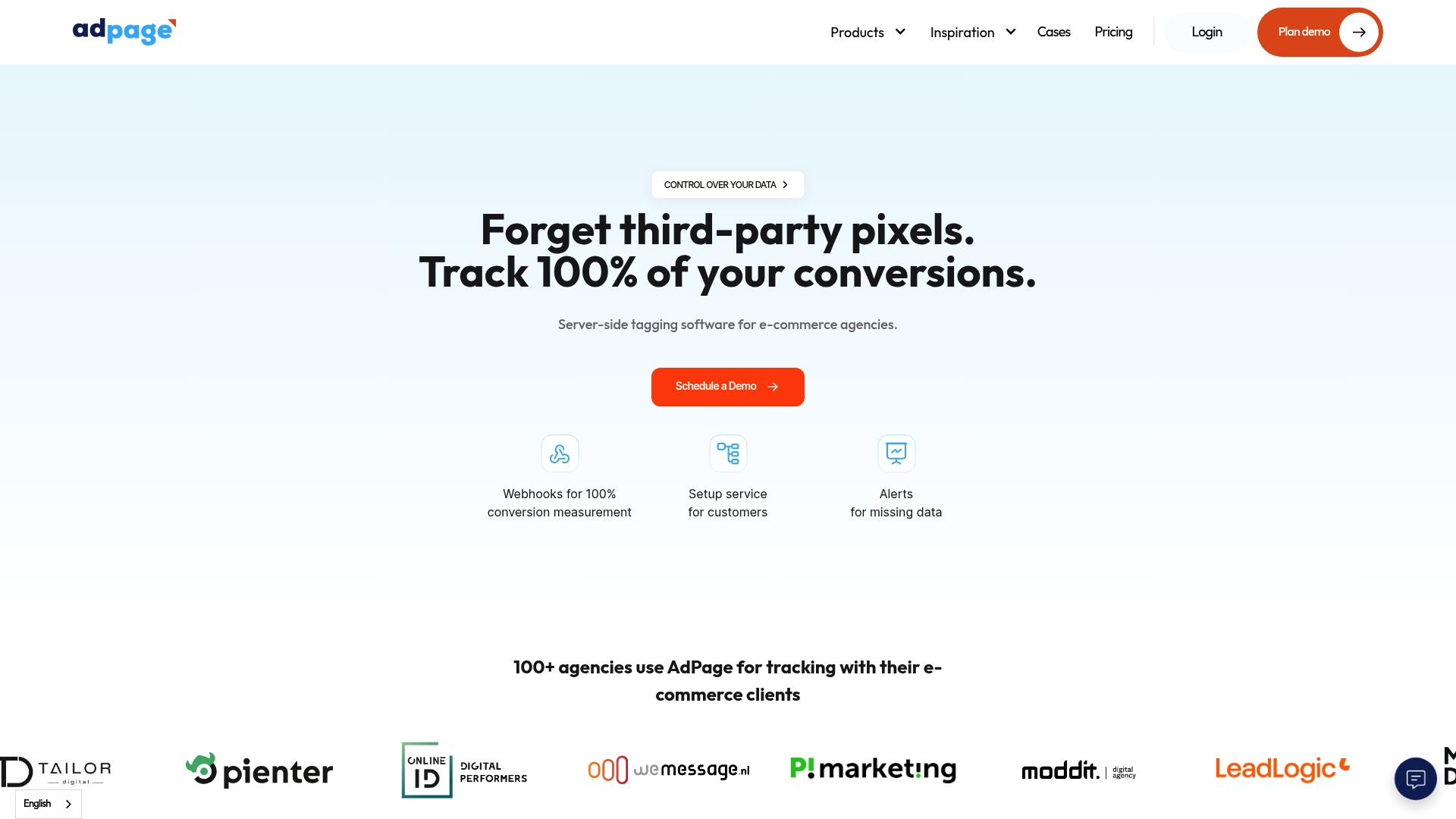E-commerce giants are pushing boundaries to win more customers than ever. You might expect that smart design or flashy ads alone would make the difference, but that hardly scratches the surface. Recent research found that AI-powered content recommendations can elevator conversion rates by a staggering 16.1%, beating many traditional tactics by miles. Curious to know what truly works? The next generation of strategies will surprise you.
Table of Contents
- Key Metrics For E-Commerce Conversion Success
- Effective Tactics To Boost Conversion Rates
- Leveraging Analytics For Continuous Improvement
- Optimising User Experience Across Devices
Quick Summary
| Takeaway | Explanation |
|---|---|
| Track crucial conversion metrics. | Measure conversion rate, average order value, and cost per acquisition to optimize your strategy. |
| Utilize advanced content recommendations. | Implement personalized and dynamic content strategies to significantly increase click-through and conversion rates. |
| Enhance conversion funnels effectively. | Simplify checkout processes and enhance user trust with reliable signals to boost conversion rates. |
| Leverage predictive analytics for insights. | Use historical data analysis to anticipate customer behaviors and tailor marketing strategies accordingly. |
| Prioritize responsive user experiences. | Ensure your e-commerce site adapts to varying devices and user needs for seamless interactions and higher engagement. |
Key Metrics for E-commerce Conversion Success
Successful e-commerce conversion optimization hinges on understanding and tracking the right performance indicators. Businesses cannot improve what they do not measure. Analytics provide the critical insights needed to transform visitor interactions into meaningful revenue streams.
Conversion Rate and Performance Fundamentals
Conversion rate represents the percentage of website visitors who complete a desired action. Research from OpenStax's Principles of Marketing highlights that this metric goes beyond simple purchase transactions. It encompasses multiple user actions such as email sign-ups, product downloads, or consultation requests.
Key conversion metrics include:
- Conversion Rate Percentage: Total conversions divided by total website visitors
- Average Order Value (AOV): Total revenue divided by number of orders
- Cost Per Acquisition (CPA): Total marketing expenses divided by number of conversions
Companies tracking these metrics systematically gain strategic advantages. Our comprehensive guide on advanced analytics provides deeper insights into interpreting these crucial performance indicators.

Below is a table summarizing the primary e-commerce conversion metrics and how they are calculated, to help clarify their meaning and usefulness.
| Metric | Calculation | What it Measures |
|---|---|---|
| Conversion Rate Percentage | (Total Conversions / Total Visitors) × 100 | Efficiency of turning visitors into customers |
| Average Order Value (AOV). | Total Revenue / Number of Orders | Average spend per transaction |
| Cost Per Acquisition (CPA). | Total Marketing Expenses / Number of Conversions | Cost to acquire each new customer |
Traffic Source Impact on Conversions
Understanding traffic sources proves critical for e-commerce conversion optimization. A 2024 academic study on e-commerce interactions revealed significant variations in conversion rates across different traffic channels. Organic search, paid advertisements, social media referrals, and direct traffic each contribute unique conversion dynamics.
Comprehensive tracking allows businesses to:
- Identify High-Performance Channels: Determine which traffic sources generate most valuable conversions
- Allocate Marketing Budget Efficiently: Invest in channels demonstrating superior conversion potential
- Develop Targeted Marketing Strategies: Create channel-specific approaches based on performance data
Advanced Conversion Tracking Considerations
Modern e-commerce conversion optimization requires sophisticated tracking mechanisms. Beyond basic metrics, businesses must analyze user behavior, engagement patterns, and conversion funnel effectiveness. Server-side tracking enables more accurate data collection, mitigating challenges presented by traditional browser-based analytics.
Professional e-commerce agencies recommend implementing:
- Comprehensive conversion funnels
- Detailed user journey mapping
- Multi-touch attribution models
- Real-time performance dashboards
By embracing these advanced tracking strategies, businesses transform raw data into actionable insights, driving continuous improvement in their e-commerce conversion performance.
Effective Tactics to Boost Conversion Rates
E-commerce conversion optimization requires strategic approaches that transform visitor interest into tangible sales. Modern businesses must deploy sophisticated tactics that go beyond traditional marketing techniques.
Content and Recommendation Optimization
Content plays a pivotal role in driving conversions. Research using multi-armed bandit algorithms demonstrates that adaptive content recommendation strategies can increase click-through rates by 6.13% and conversion rates by 16.1%. This approach involves dynamically adjusting content based on user interactions and preferences.
Key strategies for content optimization include:
- Personalized Product Recommendations: Utilize machine learning algorithms to suggest relevant products
- Dynamic Content Adaptation: Modify website content in real-time based on user behavior
- Contextual Marketing: Align content with specific user segments and interests
Our expert strategies guide offers deeper insights into implementing these advanced content techniques.
Advanced Marketing Copy Generation
Language models are revolutionizing marketing content creation. A groundbreaking study on Large Language Models (LLMs) revealed that AI-driven content generation can increase click-through rates by 12.5% and conversion rates by 8.3%. By integrating sophisticated prompt engineering and multi-objective fine-tuning, businesses can create more compelling and conversion-oriented marketing materials.
Effective approaches include:
- AI-Powered Copywriting: Generate engaging, targeted marketing content
- Automated A/B Testing: Quickly test and optimize marketing messages
- Contextual Language Optimization: Craft messages that resonate with specific audience segments
Conversion Funnel Enhancement
Optimizing the user journey is critical for improving conversion rates. Research on e-commerce traffic sources highlights the importance of a streamlined conversion funnel. Different traffic sources demonstrate varying conversion effectiveness, emphasizing the need for targeted optimization strategies.
Critical funnel optimization techniques include:
- Simplified Checkout Processes: Reduce friction in the final purchasing stage
- Mobile-Responsive Design: Ensure seamless experiences across devices
- Trust Signal Integration: implement security badges, reviews, and transparent pricing
By implementing these sophisticated tactics, e-commerce businesses can significantly improve their conversion rates, transforming visitor interactions into successful sales opportunities. The key lies in continuous testing, data-driven insights, and adaptive strategies that respond to evolving user behaviors.
The following table compares the reported impact of various advanced optimization tactics on click-through rates (CTR) and conversion rates (CR), highlighting their relative effectiveness as cited in the article.
| Tactic | Reported CTR Increase | Reported CR Increase |
|---|---|---|
| AI-powered content recommendations | 6.13% | 16.1% |
| AI-driven marketing copy generation | 12.5% | 8.3% |
Leveraging Analytics for Continuous Improvement
Successful e-commerce businesses recognize analytics as the cornerstone of strategic decision-making. Continuous improvement requires a sophisticated approach to data analysis that transforms raw information into actionable insights.
Predictive Analytics and Customer Behavior
Research on predictive analytics in e-commerce reveals the transformative potential of advanced analytical techniques. By examining historical data and customer interactions, businesses can anticipate future purchasing behaviors and design targeted strategies.
Key predictive analytics strategies include:
- Customer Segmentation: Divide audience into precise behavioral groups
- Purchase Pattern Prediction: Forecast potential buying trends
- Churn Risk Assessment: Identify customers likely to discontinue engagement
Our comprehensive analytics guide provides deeper insights into implementing these advanced techniques.
Sentiment Analysis and Operational Efficiency.
Innovative AI-driven sentiment analysis research demonstrates how advanced analytical approaches can enhance customer engagement. By interpreting nuanced customer feedback and interaction data, businesses can develop more responsive and intuitive e-commerce experiences.
Effective sentiment analysis approaches involve:
- Real-time Feedback Interpretation: Understand customer emotions and preferences
- Product Recommendation Optimization: Align suggestions with emotional context
- Customer Experience Refinement: identify pain points in user journey
Strategic Revenue Optimization
Comprehensive business analytics research highlights the critical role of data-driven strategies in achieving competitive advantage. Advanced analytics enable businesses to implement dynamic pricing, personalized marketing, and targeted interventions.
Strategic optimization techniques include:
- Dynamic Pricing Models: Adjust prices based on real-time market conditions
- Personalized Marketing Campaigns: Develop highly targeted communication strategies
- Performance Benchmarking: Compare metrics against industry standards
By embracing these sophisticated analytical approaches, e-commerce businesses can create a continuous improvement ecosystem. The key lies in transforming data into strategic insights, enabling proactive decision-making that drives sustainable growth and competitive differentiation.
Optimising User Experience Across Devices
E-commerce success in 2025 demands a seamless, intuitive user experience that transcends device boundaries. As digital interactions become increasingly complex, businesses must prioritize adaptive design strategies that accommodate diverse user needs and technological ecosystems.
Responsive Design and Performance Optimization
Research on user experience design emphasizes the critical importance of intuitive navigation and performance optimization across different devices. Successful e-commerce platforms must create experiences that adapt dynamically to screen sizes, processing capabilities, and user interaction patterns.
Key responsive design strategies include:
- Adaptive Layout Techniques: automatically adjust content and interface elements
- Performance Scaling: Optimize loading times and resource consumption
- Touch and Gesture Compatibility: Ensure smooth interactions across touchscreen and traditional interfaces
Our mobile conversion tracking guide provides deeper insights into implementing these advanced techniques.
Accessibility and Inclusive Design
Innovative research on web accessibility reveals groundbreaking approaches to creating inclusive digital experiences. By leveraging generative AI technologies, businesses can restructure webpage content to support users with diverse accessibility requirements, particularly those using screen readers.
Comprehensive accessibility approaches involve:
- Adaptive Content Structuring: Dynamically reorganize webpage hierarchies
- Intelligent Labeling Systems: Provide context-aware descriptions for interface elements
- Assistive Technology Compatibility: Ensure seamless interaction for users with different abilities
Search Relevance and User Intent
Cutting-edge research on e-commerce search optimization introduces advanced frameworks for understanding and anticipating user intent across devices. By implementing sophisticated machine learning techniques, businesses can create more intuitive and responsive search experiences.
Advanced search optimization techniques include:
- Contextual Search Algorithms: Understand user intent beyond literal keyword matching
- Cross-Device Search Consistency: Maintain search experience quality across platforms
- Personalized Recommendation Integration: Enhance search results with intelligent suggestions
Successful user experience optimization requires a holistic approach that considers technological diversity, user capabilities, and evolving digital interaction paradigms. By embracing adaptive design principles, leveraging advanced technologies, and maintaining a user-centric perspective, businesses can create compelling digital experiences that drive engagement and conversion across all devices.

Frequently Asked Questions
What are the key metrics to track for e-commerce conversion optimization?
Track essential metrics such as conversion rate percentage, average order value (AOV), and cost per acquisition (CPA) to effectively measure and enhance your e-commerce conversion success.
How can AI improve e-commerce conversion rates?
AI can enhance conversion rates through advanced content recommendations and personalized marketing strategies, with research indicating an increase in conversion rates by as much as 16.1% through these methods.
What is the importance of user experience in e-commerce conversion rates?
A seamless user experience is critical in e-commerce. Prioritizing responsive design and accessibility enhances engagement and boosts conversion rates, as users prefer sites that are easy to navigate across all devices.
How can predictive analytics benefit e-commerce businesses?
Predictive analytics helps e-commerce businesses anticipate customer behavior by analyzing historical data. This enables more targeted marketing strategies and improved customer segmentation, leading to higher conversion rates.
Achieve Real E-commerce Growth through Accurate Conversion Tracking
The article has highlighted how incomplete data and unreliable tracking can hold e-commerce brands back, especially when your business needs precise insights to boost conversion rates in 2025. If you are struggling with data loss from browser-based analytics or frustrated by gaps in your conversion funnels, you are not alone. As the article explains, switching to smarter tracking using server-side tagging is now essential for capturing every user action and unlocking higher returns on your marketing efforts.

Make sure your business stays ahead this year by ensuring every conversion is counted and every user journey is tracked, across any device. Find out how AdPage's server-side tagging solutions can help you:
- Monitor 100% of conversions with advanced consent management
- Secure data compliance for peace of mind
- Seamlessly integrate with Shopify, WooCommerce, and Magento
Ready to strengthen your analytics and see real improvements in your e-commerce results? Start optimizing with AdPage today and stop missing out on valuable insights that drive growth.



.png)
